#dlharbour – History has been made with the announcement that Dun Laoghaire town and harbour have been confirmed as the hosts for the 2016 Laser Radials Youth Worlds, and also next year's Laser Radial Men's Worlds, which will be run concurrently from 23rd to 30th July 2016. It is expected that the Youth Worlds will attract upwards of 300 entries, while the Men's Radials will bring in at least ninety sailors.
There is nothing new in a Dublin Bay club staging a major international event. And with the biennial Volvo Dun Laoghaire Regatta, the four clubs come harmoniously together to stage what is now Irish sailing's biggest happening. But what is new is that it is Dun Laoghaire/Rathdown County Council and Dun Laoghaire Harbour Company which are the lead event promoters, while the Royal St George YC is the designated club. WM Nixon takes a look at a new situation, and how it might affect Dun Laoghaire Harbour's future.
Sailors from elsewhere used to wonder at the forbearance of the Dun Laoghaire sailing community when one of the clubs was hosting a major international dinghy event. The bigger the event, the longer the time scale. There'd be a lead-in probably involving an Open National Championships which would double as a practice regatta. Then the main event itself would be preceded by at least one practice race with boat numbers now considerably swollen. And in order to qualify as a recognized international championship, the main part has to run for at least five days and most probably a week. With add-ons you could be looking at between two to three weeks of disruption for the locals, as the larger and more wealthy sailing nations have well-funded national performance squads in which time is one of the many resources they have in abundance. So their sailing stars are able to take all the time they want in familiarising themselves with the venue.
Of course such sailing superstars are welcome. But Irish sailors do like some time and space to do their own sailing, and the over-powering proximity other people's big events provides neither. Where the event involves keelboats, the shoreside disruption is admittedly lessened, but even so there will still be tented villages taking up club space. But where you have dinghies in their hundreds seeking shore space each and every evening, the disruption is total, and normal club life becomes nonexistent.
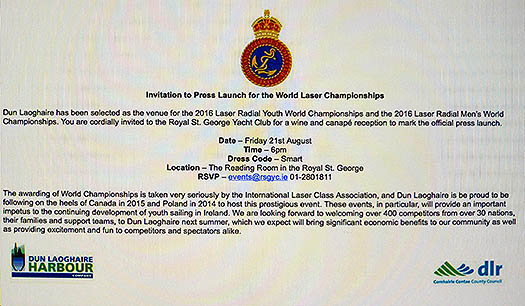
An oddly impersonal invite. No names on an invitation to signal that history was in the making. And we dressed ever so smart...
This would be acceptable if we had a genuine year-round sailing season. But let's be honest, our proper sailing season is really only between three and four months. Plus that, there is every sign that the world's sailors increasingly prefer sailing in proper warm summery weather. Thus the window of opportunity for a major fleet-attracting dinghy event in Ireland is really only from mid June to mid August.
One Dun Laoghaire club hosting a mega-event on its own is crippling for the club's ordinary day-to-day sailing, racing and training activities. But the pressure can be eased when other clubs step in to provide extra dinghy-parking space. Yet the very presence of these dinghies on their premises means that, willy nilly, these other clubs are drawn into involvement whether their members wish it or not.
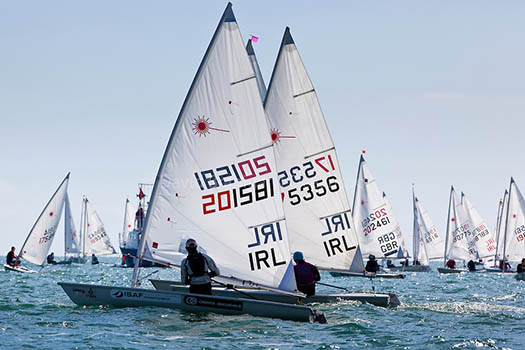
When Dublin Bay is good, it's very good. Perfect sailing conditions in the Youth Worlds 2012
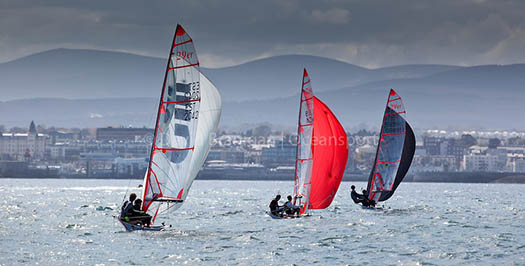
What everyone would like to see – dinghies sailing into Dun Laoghaire Harbour, in this case 29er skiffs at the 2012 Youth Worlds
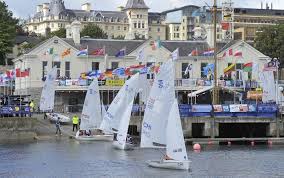
Historic clubs managed to lend themselves very well to modern dinghy racing if numbers are manageable – the National YC (founded 1870) with 420s at the Youth Worlds in 2012
A tipping point of sorts was reached with he ISAF Youth Worlds in Dublin Bay in 2012. As it progressed – and very successfully too - it became abundantly clear that a new approach would be necessary in future, with the availability of extra Harbour Company shore space becoming a priority if any or all of the Dun Laoghaire clubs were going to contemplate something on this scale again.
In the intervening three years, there has been so much turmoil around the general use and future of Dun Laoghaire Harbour that the simple and sensible idea of utilising somewhere like the Carlisle Pier as a big international events dinghy park tended to be forgotten in the noise of arguments on all the Harbour's future. The ongoing, raucous and often acrimonious debate about the Harbour's prospects in general, brought sharply into focus by the loss of the Harbour's main income stream through the withdrawal of the Stena Sealink Cross-Channel ferry – which was finally confirmed as permanent in February of this year – has made it open season for opinions on the way ahead for this massive artificial harbour.
Thus we've had all sorts of income-generating ideas from the Harbour Company flying around, such as installing a large cruiser liner berth in the middle of the harbour, which might effectively destroy the traditional in-harbour dinghy racing, or having an enormous barge converted to a sort of lido berthed at the East Pier. But the people of Dun Laoghaire had made very firm and vocal claims to it being their harbour, asserting their right to have a say in its future. And they have done so with such effectiveness that legislation is now contemplated which will eventually lead to a Bill wending its way through the Houses of the Oireachtas towards the goal of the management of Dun Laoghaire Harbour coming within the ultimate remit of Dun Laoghaire/Rathdown County Council.
Meanwhile those who deal in cool ideas rather than hot-headed arguments have been quietly beavering away behind the scenes to make the possibility of a dinghy park on Carlisle Pier a reality. It may not seem a huge project in a large artificial harbour faced with increasingly acute maintenance problems. But every journey starts with one step, and the people behind the scheme have thought it through to come up with a concept based on a massive floating slipway which can be moved out of the way if Carlisle Pier is needed for alongside berthing. In fact, a bonus is that the moveable slipway could also be used to provide dinghy retrieval at other locations in the harbour such as St Michael's Pier.
The essential thing about this project is that it is being planned in concert with the Harbour Company and the County Council – this is not some go-it-alone project by one of the clubs. With the harbour administration almost in limbo as we await further official signs of its change of status, this is something practical which can be done, it will have a very practical output, and by the end of July next year we will see what can be done when the different organisations in Dun Laoghaire finally complete work in full co-operation on something tangible, rather than just going along together using existing infrastructure.
That said, a casual attendee at the press reception in the Royal St George YC eight days ago might well wonder what all the fuss was about. Commodore Justin McKenna simply stated that the big Laser event next year was all going to happen, and Laser International Class Association Executive Secretary Jeff Martin – who had just jetted in from the Worlds in Canada – confirmed that he'd been more than happy with business meetings during the day with the Council and the Harbour Company, and having worked before with the Dun Laoghaire sailing administration team, he had complete confidence that everything required would be in place and functioning smoothly next July. With this major town & harbour event now taking shape, we can look afresh at the harbour's problems, and how town and harbour can more dynamically interact in the long run for their mutual benefit.
It seems to be the case that the ending of the cross channel ferry service – a part of Dun Laoghaire life for 150 years and more – caused something of nervous breakdown in community confidence. But instead of taking a deep breath and thinking outside the box on what the harbour might do to create a viable alternative income stream, people retreated into their shells and demanded that whatever happens to Dun Laoghaire Harbour, it must stay exactly the same.
Meanwhile the Harbour Company, charged as it is by the Government with realizing as much income as possible from the harbour, came up with ideas such as the cruise liner berthing and the floating in-harbour lido.

Getting cruise liner passengers ashore using the ship's own tenders is prone to delay through bad weather, and a long queue to get back on board – as seen here this summer in the Inner Harbour in Dun Laoghaire - reflects very badly on Irish hospitality. Photo: W M Nixon
As a small step towards the cruise liner berth, the Harbour Company had installed a pontoon in the Inner Harbour where tenders off the liners could bring passengers ashore while the ships anchored off in Dublin Bay. It was fine and dandy in good weather. But the wet and windy summer of 2015 has shown the short-comings of such a scheme, and it was on a raw evening after seeing a long queue of cruise liner folk waiting in Dun Laoghaire to be taken out to the Queen Elizabeth after delays through a gale earlier in the day, that I stated here that if cruise liners are going to be brought to Dun Laoghaire, then let it be done properly with an in-harbour berth, as it was an affront to the traditions of Irish hospitality to have people going through the liner tender experience in the Irish climate.
In the hot-headed mood around the harbour debate at the time, it was assumed from this that Aloat.ie was biased in favour of cruise liners berthing within Dun Laoghaire Harbour. This wasn't the case at all. The piece was run to try to get people to think coolly and deeply about how Dun Laoghaire Harbour might be run with the options for extra income, and our thanks to those who provided thoughtful and detailed comments. My own view, for what it's worth, is that a cruise line berth would be an option of final desperation, and that a way can surely be found to keep the harbour alive without changing it out of all recognition.
In the continuing debate, an interesting article in The Irish Times on August 6th and cross-referenced to Afloat.ie gave the viewpoint of thoughtful Dun Laoghaire resident Alison Hackett, who is not particularly interested in boats, but likes living in a seaside harbour area. She is deeply concerned about the economic future of a town which is clearly struggling economically, and whose high street needs new income from fresh sources, be it cruise liners or whatever.
But she feels that a huge liner in port will be so disproportionate that it will destroy the charm of Dun Laoghaire, so her suggestion is that liners could continue to anchor off, but their passengers could be brought ashore by a small ship, to be owned by Dun Laoghaire, a vessel which would be much more in keeping with the scale of the harbour and town.
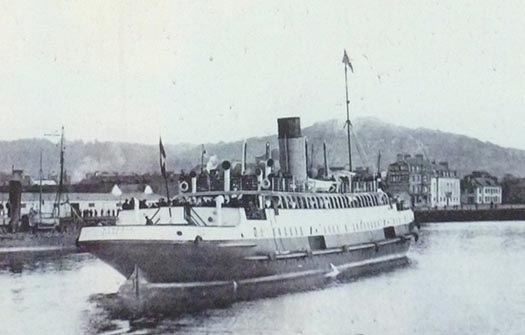
The Nomadic ferried passengers out from Cherbourg to go aboard the big liners, including the Titanic in 1912
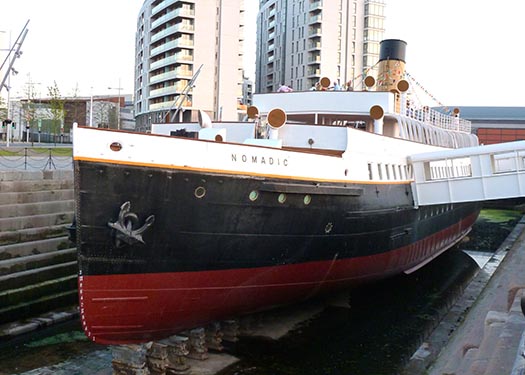
The Nomadic as she is today, restored and dry-docked in Belfast. Photo: W M Nixon
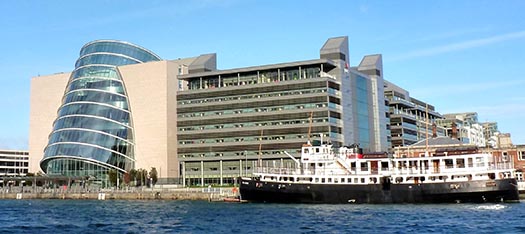
The Cill Airne (built 1939) provided a similar ferry service from Cobh out to the great liners lying-to off Cork Harbour, but the outbreak of World War II curtailed that work, and for much of her time in Cork she was a training vessel for the Maritime College. She is now the "Restaurant Boat" in Dublin. Photo: W M Nixon
If you want to see two such ships in Ireland, there's the Nomadic now preserved in Belfast – she was Cunard White Star's service vessel at Cherbourg and thus brought a couple of hundred passengers out to the ill-fated Titanic, which was too large to enter the port – and nearer Dun Laoghaire, there is of course the Cill Airne, which was built in 1939 to serve as the liner tender operating out of Cobh, and is now the "Restaurant Boat" in Dublin's River Liffey beside the Conference Centre.
The problem with this solution – apart from the fact that Dun Loaghaire would have to maintain such a vessel to the highest passenger-carrying standards - is that both the Nomadic and the Cill Airne were serving scheduled services, and being used by people who very specifically wanted to get from A to B, whereas cruise liner passengers are a different breed - they want to come and go as they please, and being conveniently berthed alongside is very much their preference.
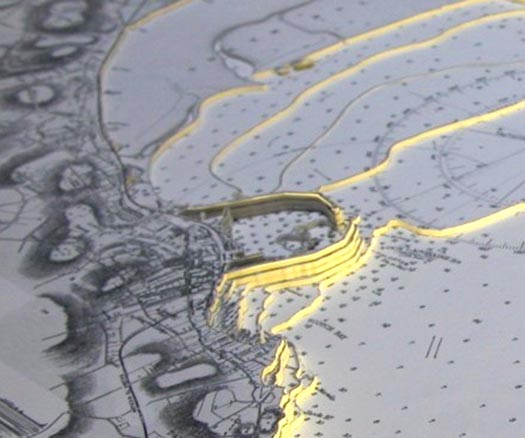
A "natural shape"? The artificial and high-maintenance nature of Dun Laoghaire Harbour is evident from this 3D chart
But if we don't see the installation of a cruise liner berth, or at least the setting up of Alison Hackett's solution, where on earth is the money now needed to keep Dun Laoghaire Harbur intact? For although Alison Hackett also enthused about Dun Laoghaire Harbour's lovely "natural shape", it is actually about as natural as the GPO or the twin stacks of Poolbeg. They're pleasing in form, so they seem natural, but "naturally-shaped" Dun Laoghaire is so utterly artificial that the only way you can really grasp it is by studying one of the 3D charts made by Latitude Kinsale, and a few seconds assessing that makes you realise why Dun Laoghaire needs a lot of maintenance money, and all the time.
Nevertheless we can see the attraction of the suggestion by Liam Shanahan Senr and others that Dun Laoghaire should be seen as the sea's equivalent of the Phoenix Park, and should therefore be preserved as nearly original and intact as possible, and be there for the benefit of all if they care to use it.
Which means that the sailing community, far from retreating into their shells, should maybe reach out a bit more, as in the end it looks as though their facilities are basically going be underwritten by the taxpayers of all Ireland if the activists of Dun Laoghaire township have their way.
So dare we suggest that if the harbour is going to be kept clear and in-harbour sailing can continue, can we not have a bit more of it? A couple of dozen Water Wags and eighteen or so Lasers out racing in the harbour on a sweet and gentle summer evening is all very well, but really the numbers are pathetic. The message might well be: Use It Or Lose It. And while we're on this topic, would it really be so difficult to finish Dublin Bay SC races in the harbour, as they were in times past? Nothing has so separated the town from sailing as the decision to have everything done from Committee Boats out in the bay.
Finally, the matter of that lido barge.....At the reception in the George, a totally reliable source told me – off the record – that we needn't worry about it for quite some time, if at all. Apart from the €2 million plus to build it, the place where it was going to be berthed at the East Pier is no longer fit for purpose. In fact, it has deteriorated so much that no significant vessel has berthed there for maybe five years. So it would be downright dangerous and irresponsible to berth a great lumbering engine-less barge in this spot where a significant rumble can be running in certain winds.
It's information we received with mixed feelings, for that berth is the most visible in the harbour. It's difficult to get a proper sight of boats elsewhere in Dun Laoghaire, and in the marina you lose them completely. But that East Pier berth really was where handsome vessels could be on show, and there was always a special proud feeling of the people's ship being in port and on display when Asgard II was there.
It was twelve years ago that I spotted a mighty schooner in the berth, and here she is in all her glory - the three-masted Shenandoa. On a grey sort of an afternoon in Dun Laoghaire, she brought a whiff of the blue high seas and the romance of sail to Dun Laoghaire. And a photo I found the other day of her going at full chat shows that all the promise indicated at the East Pier is more than fulfilled out on the ocean. But you have to work for an effect like this. If you're tearing along in this style on Shenandoa and wish to tack, you have to remember to lower both the forward topsails, as the inter-mast stays get in their way. Is that labour-intensive or what?
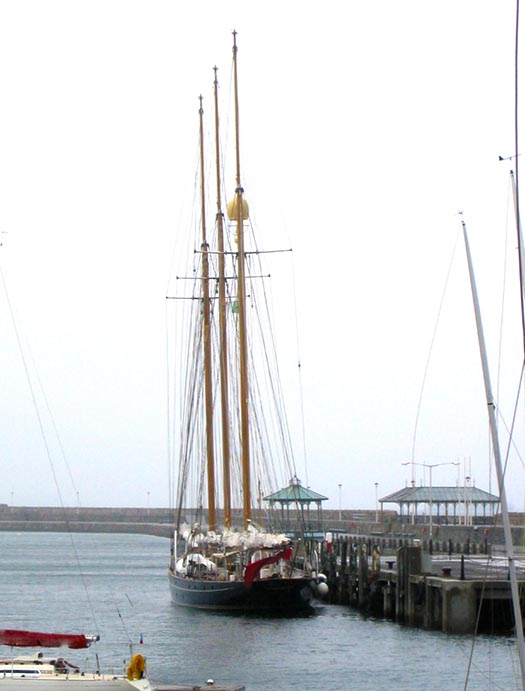
A big one at the East Pier berth a dozen years ago.....Photo: W M Nixon
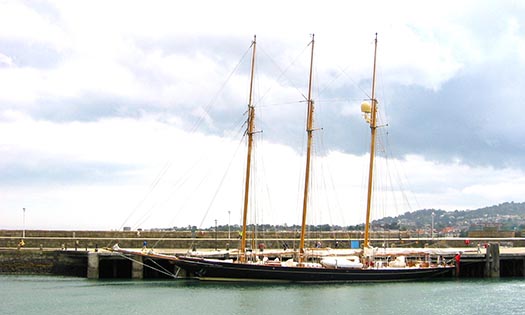
The berth at the East Pier – now reckoned unsafe – is one of the few places in Dun Laoghaire where you could get a good view of an interesting ship in port. This is the schooner Shenandoa. Photo: W M Nixon
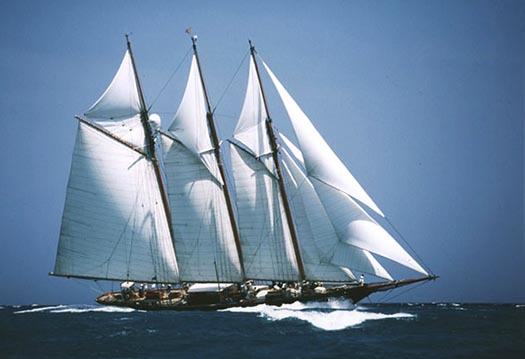
All the promise of her appearance in Dun Laoghaire Harbour is borne out when Shenandoa is at sea under full sail. But don't expect a sudden tack – you have to lower the two forward topsails first...






























































